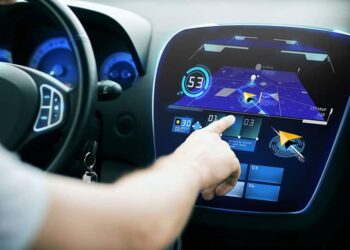In a world relentlessly propelled forward by innovation, the tools we use are no longer merely functional objects; they are sophisticated instruments that actively define our capabilities and reshape our realities. From the microscopic components powering artificial intelligence to the macroscopic machines navigating complex environments, cutting-edge gear represents the vanguard of technological progress. This in-depth exploration delves into the most revolutionary equipment emerging across various sectors, uncovering how these pioneering devices are not just incremental improvements, but fundamental shifts in design, utility, and impact, driving us towards unprecedented levels of efficiency, intelligence, and human-computer symbiosis.
Advanced AI Hardware

The incredible leaps in Artificial Intelligence (AI) are not solely due to algorithms; they are equally reliant on the specialized hardware built to process immense datasets and execute complex computations with unparalleled speed and efficiency. This new generation of processors and systems is enabling AI to transcend theoretical limits and deliver tangible results.
A. AI Accelerators and Graphics Processing Units (GPUs): While general-purpose Central Processing Units (CPUs) handle a wide range of tasks, GPUs, originally designed for rendering graphics, have become indispensable for AI. Their parallel processing architecture makes them exceptionally efficient at handling the matrix multiplications crucial for deep learning training. Beyond standard GPUs, dedicated AI accelerators like Google’s Tensor Processing Units (TPUs) and specialized Neural Processing Units (NPUs) in consumer devices are purpose-built for AI workloads. These chips optimize for AI inference (applying a trained model to new data) and training, offering dramatic power efficiency and speed improvements, making AI applications feasible even on mobile devices. This specialized hardware is the engine behind rapid advancements in image recognition, natural language processing, and complex AI model development.
B. Neuromorphic Computing Chips: Inspired by the human brain’s structure and function, neuromorphic chips aim to process information in a fundamentally different way than traditional Von Neumann architectures. Instead of separating processing and memory, neuromorphic chips integrate them, allowing for highly energy-efficient and parallel computation. Projects like IBM’s TrueNorth and Intel’s Loihi are exploring these architectures, which hold immense promise for AI tasks that require continuous learning, adaptability, and pattern recognition with minimal power consumption. Imagine AI systems that “think” more like a biological brain, capable of learning from experiences in real-time with far less energy. This gear could unlock entirely new paradigms for autonomous systems and intelligent robotics.
C. Edge AI Processors: As AI moves from massive data centers to everyday devices, the need for efficient “edge AI” processing becomes critical. Edge AI processors are designed to perform AI computations directly on the device (e.g., a smartphone, a smart camera, an industrial sensor) rather than sending data to the cloud. This reduces latency, enhances privacy, and conserves bandwidth. These low-power, high-performance chips are crucial for real-time applications such as facial recognition on security cameras, voice assistants responding instantly without an internet connection, and autonomous vehicles making split-second decisions based on local sensor data. They enable a distributed, more resilient AI ecosystem.
D. Quantum Computing Hardware (Early Stages): While still largely experimental, quantum computing hardware represents the ultimate frontier in computational power, capable of solving problems intractable for even the most powerful supercomputers. Quantum bits (qubits), unlike classical bits, can exist in multiple states simultaneously (superposition) and be entangled, allowing for exponential increases in processing power for specific types of problems. Companies like IBM, Google, and Rigetti are developing quantum processors using technologies such as superconducting circuits and trapped ions. This gear is poised to revolutionize fields like drug discovery, material science, financial modeling, and cryptography, although practical, stable quantum computers are still some years away from widespread use. The ability to manipulate matter at a quantum level offers unprecedented potential for designing new catalysts, understanding complex biological processes, and breaking modern encryption.
Advanced Robotics and Autonomous Systems
Robotics and autonomous systems are transitioning from controlled industrial environments to dynamic, unpredictable real-world scenarios, thanks to sophisticated hardware and advanced AI integration.
A. Collaborative Robots (Cobots): Unlike traditional industrial robots confined to cages, cobots are designed to work safely alongside humans. Equipped with advanced sensors, force-torque limiters, and intuitive programming interfaces, they can assist with tasks that require precision, repetitive motion, or heavy lifting, without posing a threat to human colleagues. Cobots enhance productivity, improve ergonomics for workers, and are more flexible for small-batch production, making advanced automation accessible to a wider range of industries, including small and medium-sized enterprises. Their ease of integration into existing workflows makes them a prime example of human-robot collaboration.
B. Autonomous Ground Vehicles (AGVs) and Drones: Beyond self-driving cars, AGVs are revolutionizing logistics and last-mile delivery. Automated forklifts, delivery robots, and even autonomous agricultural machinery are improving efficiency and safety in warehouses, factories, and farms. Simultaneously, advanced drones equipped with high-resolution cameras, LiDAR, and sophisticated navigation systems are transforming aerial inspection, mapping, surveillance, and even urban air mobility. These versatile machines, capable of complex flight paths and payload delivery, are becoming indispensable tools across a multitude of applications, from infrastructure inspection to disaster response, delivering medical supplies to remote areas, or monitoring environmental changes.
C. Humanoid and Bipedal Robotics: The development of humanoid and bipedal robots like Boston Dynamics’ Atlas and Figure AI’s humanoid robots represents a monumental engineering feat. These robots are designed to navigate human-centric environments, walk over uneven terrain, climb stairs, and manipulate objects with increasing dexterity. While still primarily research platforms, their advanced actuators, balance systems, and AI-driven locomotion algorithms are paving the way for future service robots capable of performing complex tasks in homes, hospitals, and even hazardous environments too dangerous for humans. The challenges of dynamic balance and complex manipulation, once thought insurmountable, are rapidly being overcome by this cutting-edge gear.
D. Surgical Robotics and Medical Devices: In the medical field, cutting-edge robotic systems are transforming surgery, diagnostics, and patient care. Robotic surgical assistants offer surgeons enhanced precision, dexterity, and visualization for minimally invasive procedures, leading to faster recovery times and reduced complications. Beyond the operating room, automated lab systems, robotic pharmacies, and remote consultation robots are improving efficiency and accessibility in healthcare delivery. These devices are pushing the boundaries of what’s possible in patient treatment and medical research, allowing for more precise biopsies, targeted radiation therapy, and even micro-surgery within the human body.
Immersive Realms

The boundaries between the physical and digital worlds are blurring rapidly, driven by increasingly sophisticated Extended Reality (XR) hardware, encompassing Virtual Reality (VR), Augmented Reality (AR), and Mixed Reality (MR).
A. High-Resolution VR Headsets and Haptics: Modern VR headsets are moving towards higher resolution displays, wider fields of view, and improved optical clarity, aiming for a truly seamless visual experience. Foveated rendering, where only the area you’re looking at is rendered in high detail, optimizes performance. Accompanying these visuals are advanced haptic feedback systems—gloves, vests, or full-body suits—that simulate tactile sensations like pressure, texture, and temperature. This multi-sensory immersion is transforming training, gaming, remote collaboration, and therapeutic applications, making virtual experiences incredibly realistic for everything from flight simulations to pain management.
B. Lightweight AR Glasses and Smart Contact Lenses: The goal for AR is ubiquitous, unobtrusive integration into daily life. Current AR headsets are becoming lighter and more compact, resembling regular glasses. The ultimate vision includes smart contact lenses that project digital information directly onto the retina, offering a truly invisible AR experience. This gear has immense potential for navigation, real-time information overlay (e.g., recognizing faces, translating languages), and professional applications like assisting technicians with repair instructions superimposed on machinery. Imagine effortlessly accessing data or interacting with digital objects without ever looking at a screen.
C. Mixed Reality (MR) Devices: MR devices, such as Microsoft’s HoloLens, blend the real and virtual more deeply than AR. They allow digital objects to not only appear in the real world but also interact with it, responding to real-world physics and occlusion. This enables powerful applications in collaborative design, remote assistance, and interactive entertainment where digital creations can be manipulated as if they were physical objects within your actual environment. This hardware creates truly hybrid realities for enhanced creativity, communication, and complex problem-solving in fields like architecture, engineering, and education.
D. Motion Tracking and Body Scanning Gear: To accurately map user movements within immersive environments, advanced motion tracking systems are crucial. These include optical tracking with external cameras, inside-out tracking integrated into headsets, and inertial measurement units (IMUs) in controllers or full-body suits. Combined with sophisticated 3D body scanning gear, this allows for highly realistic avatar representation and precise interaction, enhancing the sense of presence and enabling applications from virtual fashion try-ons to personalized fitness coaching within simulated environments. The precision of these systems also fuels advancements in animation and biomechanical analysis.
Sustainable and Energy Tech
As the demand for energy grows, cutting-edge gear is emerging to revolutionize how we generate, store, and manage power, prioritizing sustainability and efficiency.
A. Next-Generation Battery Technologies: Lithium-ion batteries have powered much of the modern tech revolution, but next-gen battery technologies promise even greater energy density, faster charging, and enhanced safety. Solid-state batteries, which replace liquid electrolytes with solid ones, are safer and offer higher energy capacity. Other promising technologies include sodium-ion, flow batteries, and even advanced supercapacitors, which could revolutionize electric vehicles, grid-scale energy storage, and long-lasting portable devices, making renewable energy more reliable and accessible. These advancements are crucial for a truly sustainable energy ecosystem.
B. Advanced Solar and Wind Energy Equipment: While solar panels and wind turbines are established, constant innovation is leading to more efficient and resilient designs. Perovskite solar cells promise higher efficiency at lower costs, potentially making solar power more competitive in various environments and applications, including flexible and transparent surfaces. Offshore wind turbines are growing in size and efficiency, capturing stronger, more consistent winds further from land. Innovations in materials science and aerodynamics are driving down the cost per kilowatt-hour, making these renewable energy sources increasingly viable alternatives to fossil fuels.
C. Smart Grid and Energy Management Systems: To effectively integrate diverse renewable energy sources and manage demand, smart grid technologies are essential. This includes advanced sensors, communication networks, and AI-powered software that monitors and optimizes energy flow across the grid in real-time. Smart meters, home energy management systems, and grid-scale battery storage solutions are cutting-edge gear that allows for dynamic energy pricing, demand response, and more resilient and efficient power distribution, reducing waste and enhancing grid stability. These systems are pivotal in transitioning to a decentralized, intelligent energy infrastructure.
D. Carbon Capture and Storage (CCS) Technologies: As the world grapples with climate change, cutting-edge gear for carbon capture and storage is becoming increasingly vital. This includes direct air capture (DAC) machines that pull CO2 directly from the atmosphere, industrial capture systems that filter emissions from power plants, and innovative storage solutions that sequester CO2 underground. While still in early stages of scalability, these technologies are crucial tools for mitigating greenhouse gas emissions and achieving net-zero targets. The development of more energy-efficient capture materials and processes is a key focus for this essential equipment.
Bio-Integrated Devices and Health Tech
The intersection of biology and technology is giving rise to groundbreaking gear that promises to revolutionize healthcare, enhance human capabilities, and foster deeper understanding of our own bodies.
A. Advanced Wearables for Continuous Health Monitoring: Beyond smartwatches, new wearable tech is moving towards more comprehensive and clinical-grade health monitoring. This includes smart patches that continuously monitor vital signs, glucose levels, or even drug delivery. Smart rings offer discreet tracking of sleep, heart rate variability, and activity. These devices provide proactive health insights, early detection of anomalies, and personalized wellness recommendations, empowering individuals to take more control over their health and enabling early intervention for conditions like heart disease or diabetes.
B. Brain-Computer Interfaces (BCIs): BCIs represent one of the most revolutionary areas of human-computer interaction. Non-invasive BCIs (e.g., EEG-based headsets) allow users to control devices with thought or improve focus. Invasive BCIs, such as Neuralink, aim for direct communication between the brain and external devices, with potential applications for restoring mobility to paralyzed individuals, allowing communication for those with locked-in syndrome, and potentially enhancing cognitive function. This gear could fundamentally alter how humans interact with technology and even each other, opening up possibilities for telepathy-like communication or enhanced learning.
C. Personalized Medical Diagnostics and Therapeutics: Cutting-edge diagnostic gear is becoming more portable, precise, and personalized. Handheld ultrasound devices, smartphone-connected lab-on-a-chip diagnostic tools for rapid testing, and AI-powered image analysis systems are revolutionizing point-of-care diagnostics. In therapeutics, smart drug delivery systems, personalized implantable devices, and gene-editing tools like CRISPR-Cas9 are offering highly targeted and effective treatments tailored to individual patient needs, ushering in an era of precision medicine. The ability to diagnose diseases earlier and treat them with unprecedented specificity is a monumental leap.
D. Exoskeletons and Advanced Prosthetics: Robotic exoskeletons are empowering individuals with mobility impairments to walk, stand, and regain independence. These devices, controlled by sophisticated sensors and motors, assist with movement and provide support, often with gait training capabilities. Similarly, advanced prosthetic limbs are no longer just passive replacements; they incorporate sophisticated sensors, microprocessors, and motors, often controlled by muscle signals (myoelectric control), offering highly dexterous and natural movements for amputees, significantly improving their quality of life and functional capabilities.
Cutting-Edge Manufacturing & Exploration Gear
The tools that build our future, and those that help us explore new frontiers, are also undergoing rapid transformation.
A. Additive Manufacturing (Advanced 3D Printers): Beyond consumer-grade 3D printers, industrial additive manufacturing is pushing boundaries with new materials (metals, ceramics, composites) and techniques (e.g., direct energy deposition, binder jetting). This cutting-edge gear enables the creation of highly complex geometries, lightweight structures, and custom parts on demand, revolutionizing aerospace, automotive, medical device manufacturing, and even construction, allowing for rapid prototyping and mass customization. The ability to print entire houses or critical aircraft components on site drastically changes supply chains and production efficiencies.
B. Precision Metrology and Inspection Tools: In advanced manufacturing, extreme precision is paramount. Cutting-edge metrology gear includes laser trackers, computed tomography (CT) scanners, and optical measurement systems capable of sub-micron accuracy. These tools ensure the quality control of highly complex components, from microprocessors to aircraft parts, enabling the production of increasingly sophisticated technologies. The ability to detect minuscule flaws before they become critical failures is crucial for high-stakes industries.
C. Deep-Sea and Space Exploration Vehicles: For exploring the most extreme environments, cutting-edge gear is essential. Remotely Operated Vehicles (ROVs) and Autonomous Underwater Vehicles (AUVs) with advanced sensors and manipulators are exploring the deep ocean, discovering new species, and mapping unexplored territories. In space, next-generation rockets, reusable spacecraft, and advanced robotic probes with sophisticated scientific instruments are pushing the boundaries of interplanetary exploration, searching for life beyond Earth and unlocking the secrets of the cosmos. These vehicles are equipped with groundbreaking materials and propulsion systems to withstand extreme conditions.
D. Advanced Material Development Equipment: The creation of new materials with unprecedented properties relies on highly specialized equipment. This includes high-pressure synthesis systems for creating new crystalline structures, advanced microscopes for atomic-level material characterization (e.g., scanning tunneling microscopes), and specialized reactors for producing novel polymers or composites. These tools are fundamental to breakthroughs in everything from lightweight aerospace alloys to highly efficient energy materials, enabling the very development of the next generation of cutting-edge gear itself.
Challenges and Ethical Considerations
The emergence of this cutting-edge gear brings with it not only incredible opportunities but also significant challenges and ethical considerations that demand thoughtful attention.
A. Data Security and Privacy Concerns: Many advanced devices, particularly those collecting sensitive health data or operating autonomously, gather vast amounts of information. Ensuring robust cybersecurity measures and maintaining strict data privacy protocols are critical to protect individuals and systems from malicious actors or misuse. The more interconnected our devices become, the larger the potential attack surface for cyber threats.
B. Job Displacement and Workforce Adaptation: The increasing automation and advanced capabilities of new gear may lead to job displacement in certain sectors. Societies must invest in reskilling and education programs to prepare the workforce for new roles that emerge alongside these technologies, fostering adaptability and lifelong learning. The focus shifts from repetitive tasks to roles requiring creativity, critical thinking, and problem-solving alongside these new tools.
C. Ethical AI and Algorithmic Bias: As AI hardware becomes more powerful, the ethical implications of the AI models running on them become more pronounced. Ensuring AI systems are fair, transparent, and free from embedded biases is crucial, especially in applications affecting critical decisions like healthcare, finance, or legal judgments. The data used to train these systems must be carefully curated to avoid perpetuating societal inequalities.
D. Responsible Development and Regulation: The rapid pace of innovation often outstrips regulatory frameworks. Establishing clear ethical guidelines and effective, yet flexible, regulations for areas like bio-integrated devices, autonomous systems, and advanced robotics is essential to ensure responsible development and prevent unintended negative consequences, such as privacy erosion or unintended societal disruption. International cooperation is key here.
E. Accessibility and Equitable Distribution: While cutting-edge gear offers immense potential, there’s a risk it could exacerbate existing digital or economic divides if access remains exclusive to a privileged few. Efforts to ensure equitable distribution and affordability are vital to allow all segments of society to benefit from these advancements, preventing a scenario where powerful tools only serve to widen the gap between the technologically rich and the technologically poor.
Conclusion
In conclusion, the relentless pursuit of innovation is yielding a remarkable array of cutting-edge gear that is poised to fundamentally reshape every facet of human existence. From the microscopic quantum bits that promise unimaginable computational power to the macroscopic robotic systems exploring the farthest reaches of our planet and beyond, these pioneering tools are redefining what is possible. While navigating the complex ethical and societal implications will be a continuous journey, the sheer ingenuity embedded within this next generation of equipment promises a future of unparalleled capabilities and profound transformation. Embracing these advancements wisely will unlock a new era of human achievement.













